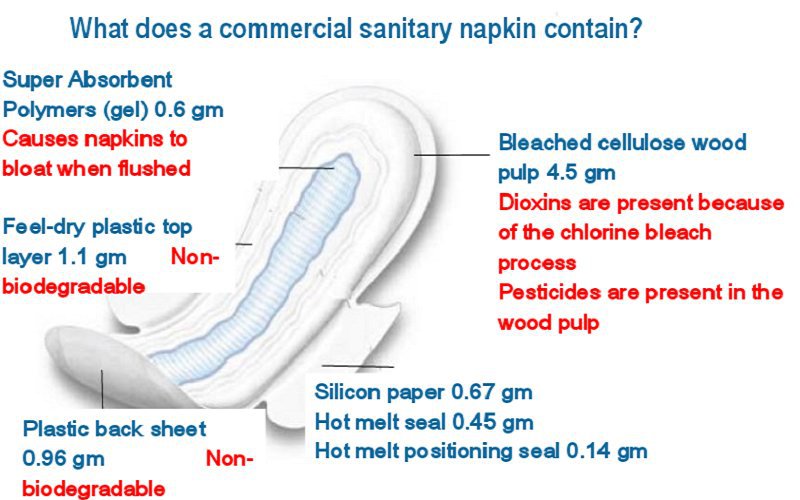
Wearing a sanitary or maxi pad can sometimes leave something unwanted behind — a rash. This can lead to itching, swelling, and redness.
Sometimes the rash can be the result of irritation from something the pad is made from. Other times the combination of moisture and heat can contribute to bacterial buildup.
Regardless of the underlying cause, there are several treatments available to treat rashes from pads.
What are the causes of rashes from pads?
Most rashes from pads are the result of contact dermatitis. This means your skin has come in contact with something irritating in your sanitary pad. Contact dermatitis of the vulva is known as vulvitis.
ALSO READ:Deadly bacteria found in makeup
ALSO READ:Deadly bacteria found in makeup
Pads are typically made from several layers of different materials. Each material has the potential to irritate your skin. Examples of common components in a sanitary pad include:
Back sheet
The back sheet of a sanitary pad is often made of compounds called polyolefins. These are also used in clothing, straws, and ropes.
Absorbent core
The absorbent core is usually between the back sheet and top sheet. It’s made from absorbent foam and wood cellulose, a highly absorbent material. Sometimes, it may contain absorbent gels as well.
Top sheet
The top sheet of a sanitary pad is the one that comes in contact most often with your skin. Examples of components of top sheets include polyolefins as well as zinc oxide and petrolatum, which are often used in skin moisturizers.
Adhesive
Adhesives are on the back of the pad and help the pad stick to underwear. Some are prepared with FDA-approved glues similar to those in craft glue sticks.
Fragrances
In addition to these components, some manufacturers may add fragrances to their pads. Some women’s skin may be sensitive to the chemicals used to provide fragrance. However, most pads place a fragrance layer underneath the absorbent core. This means the fragranced core is unlikely to come in contact with your skin.
While rashes and allergic irritation can occur, it’s usually rare. One study calculated an estimated 0.7 percent
of skin rashes were from allergies to an adhesive in sanitary pads. Another study reported the incidence of significant irritation from maxi pads was only one per two million pads used.
In addition to dermatitis from the components of the sanitary pad itself, the friction from wearing a pad has the potential to irritate sensitive skin and lead to a rash.
ALSO READ: Genetic differences help distinguish type 1 diabetes in children from 'type 1.5' in adults
ALSO READ: Genetic differences help distinguish type 1 diabetes in children from 'type 1.5' in adults
How can the rash be treated?
It may take some trial and error to treat a rash caused by a pad.
- Use unscented pads.
- Wear loose cotton underwear to reduce friction.
- Try a different brand to determine if it causes fewer reactions.
- Apply an over-the-counter hydrocortisone cream to the outer vulva area if it’s affected. You should not put hydrocortisone cream inside the vaginal canal.
- Use a sitz bath to relieve irritated areas. You can purchase a sitz bath at most drugstores. These special baths usually sit over a toilet. Fill the bath with warm (not hot) water and sit in it for 5 to 10 minutes, then pat the area dry.
- Change pads frequently to prevent them from becoming too moist and increasing your risk of irritation.
Treat any irritation from a pad as soon as you notice it. Untreated rashes could lead to a yeast infection as the yeast naturally present in your body can affect the irritated areas.
What is the outlook for a rash caused by a pad?
Rashes caused by friction may go away within two to three days if they’re treated as soon as you notice symptoms. Rashes that are untreated can become more serious and may take longer to treat.
ALSO READ:How soon can pregnancy be detected?
ALSO READ:How soon can pregnancy be detected?
How can you prevent a rash from developing in the future?
Rashes from pads can present a challenge if pads are your preferred method to protect your clothing from menstrual blood. To prevent future irritation:
- Switch to an all-cotton pad that doesn’t contain dyes or different adhesives. These pads are more expensive, but they may help prevent rashes if you have sensitive skin.
- Opt for washable cloth pads or special cups that can absorb menstrual blood without causing significant irritation.
- Change pads frequently and wear loose-fitting underwear.
- To prevent yeast infections, apply an antifungal ointment right before the start of your period.
if you have comment please drop it down in comment section




ليست هناك تعليقات:
إرسال تعليق
Due to the high number of spammy comments we have decided to initiate comment moderation so that we can maintain our quality standards and make good environment for our visitors. Please leave your comment